06/23/21
K-State Current - June 23, 2021
K-State Current is a weekly news update for the Kansas Board of Regents to apprise the Regents on a few of the many successes and achievements made by K-State faculty, staff and students.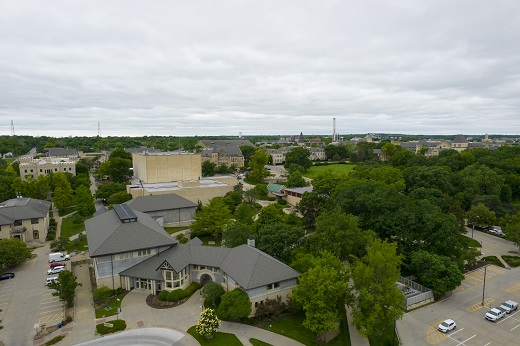
K-State News
Seek magazine receives international CASE Circle of Excellence gold award
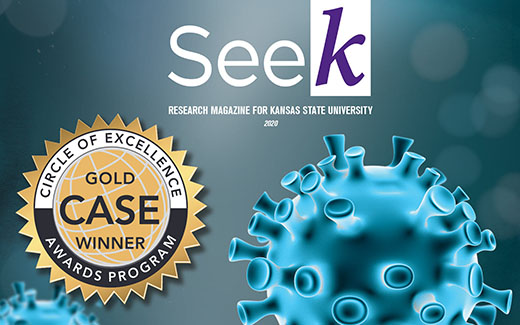 Kansas State University's flagship research publication is taking the gold with a prestigious international award. The Council for Advancement and Support of Education, or CASE, has recognized Seek magazine with a gold 2021 Circle of Excellence award.
Kansas State University's flagship research publication is taking the gold with a prestigious international award. The Council for Advancement and Support of Education, or CASE, has recognized Seek magazine with a gold 2021 Circle of Excellence award.
The gold award honors the 2020 issue of Seek in the periodicals and magazines design category. Seek magazine is the university's flagship research magazine and invites readers to "See" "K"-State's research, scholarly and creative activities, and discoveries. The magazine includes a print publication as well as the website k-state.edu/seek.
"Once again K-State has proven the power of collaboration in communications," said Jeff Morris, vice president of communications and marketing. "Seek is a team effort and we are very grateful to our partners who help make this one of the premier publications in the nation."
CASE is an international association of educational institutions. The Circle of Excellence Awards are international awards and showcase outstanding work in advancement services, alumni relations, communications, fundraising and marketing at colleges, universities, independent schools and affiliated nonprofits around the world.
In 2021, CASE received almost 3,000 entries from 27 countries. Those entries came from 530 institutions for consideration across 100 categories.
"This international recognition truly demonstrates the commitment of K-State researchers and communicators to fulfilling our land-grant mission of sharing research and knowledge with Kansas, the nation and the world," said Beth Montelone, K-State interim vice president for research.
Seek is a collaboration among the Office of the Vice President for Research, the Division of Communications and Marketing and other university communicators. In addition to the 2021 Circle of Excellence gold award, the magazine has received 19 CASE awards since publication began in spring 2016, including one Circle of Excellence silver award, one grand gold District VI award, 12 gold District VI awards, three silver District VI awards and two bronze District VI awards.
A 15-member in-house team — including designers, photographers and writers — created the 2020 issue of Seek magazine.
The 2020 issue of Seek was a special "mega" issue that featured K-State research focused on fighting the COVID-19 pandemic in multiple disciplines. The 2020 issue also featured student architecture projects to design affordable housing, highlighted a decade of K-State research, described pioneering new research on industrial hemp and shared how scientists are protecting the U.S. swine industry.
In their feedback, the CASE award judges offered the following comments: "Airy and classic design, minimal but impactful design thinking. Stunning photography and strong design sense draws the reader in, and makes every page pleasing to look at. Dynamic and bold color choices tie the cohesion together for this publication."
Study: Rising nighttime temps rob yields in rice, wheat
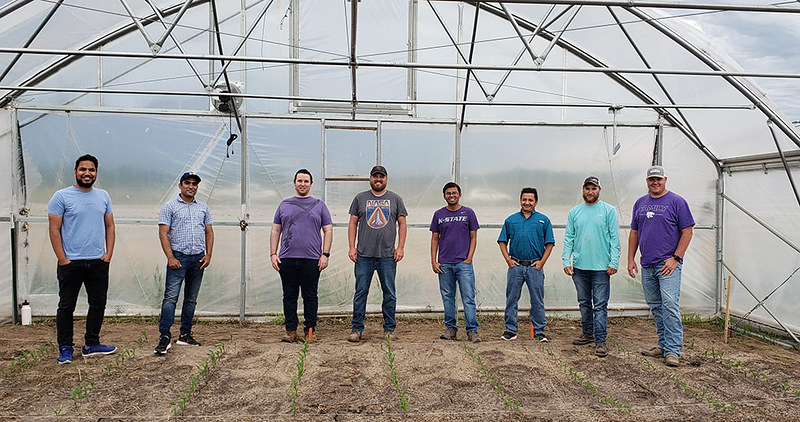 A Kansas State University research team led by Krishna Jagadish (pictured fourth from right) is using climate-controlled tents to study the effect of high nighttime temperatures on corn, wheat and other crops.
A Kansas State University research team led by Krishna Jagadish (pictured fourth from right) is using climate-controlled tents to study the effect of high nighttime temperatures on corn, wheat and other crops.
Warmer nights can upset a good night’s sleep for humans, but could the biological processes of farm crops be fussy about nighttime temperatures, too?
Researchers at Kansas State University and North Carolina State University think so, and they’ve got a growing amount of evidence to prove that the circadian clock genes in rice -- and possibly wheat -- get messed up when nights get hotter.
“We still don’t know all the details, but we’re narrowing down the key regulatory players,” said Colleen Doherty, an associate professor of biochemistry at North Carolina State University.
Doherty and K-State professor and crop physiologist Krishna Jagadish began studying the impact of nighttime temperatures seven years ago when Jagadish worked at the International Rice Research Institute in the Philippines.
“Essentially, we found that warmer nights throw the rice plant’s internal clock out of whack,” Doherty said.
Jagadish said warm temperatures cause “hundreds of genes” to be expressed earlier than usual, and hundreds more to be expressed later than usual. That disrupts such key biological processes as photosynthesis and respiration (a process that uses sugars produced during photosynthesis to create energy for plant growth).
In field trials with rice, Jagadish used artificial heaters in field conditions to maintain experimental plots at 2 degrees Celsius above ambient temperature, and compared samples – taken every three hours for 24 hours -- from plots that were grown at ambient temperature.
Similar studies at K-State have indicated a 5% reduction in wheat yield for each one degree Celsius increase in temperature, according to Jagadish. For wheat, he added, “these changes in grain composition under warming nights will impact both the quantity and quality of bread.”
“Most people think plants aren’t dynamic, but they are,” Doherty said. “Plants are constantly regulating their biological processes – gearing up for photosynthesis just before dawn, winding that down in the late afternoon, determining precisely how and where to burn their energy resources. Plants are busy, it’s just difficult to observe all that activity from the outside.
“And what we learned is that the clock responsible for regulating all of that activity gets messed up when the nights get hotter relative to the days.”
Doherty is currently focusing her work on rice, while Jagadish has studied the impact of nighttime temperatures on rice and wheat. “Rice and wheat behave similarly to warming nights, so progress made with one crop can benefit the other,” Jagadish said.
The researchers’ goal is to better identify the factors that create havoc with the plants’ circadian rhythms so that scientists can breed varieties that perform better under conditions where higher nighttime temperatures are present.
“It’s the high-starch cereal crops that are most vulnerable to high nighttime temperatures,” Jagadish said. He and his team are currently studying the impact of nighttime temperatures on corn at K-State’s north farm in Manhattan.
“Corn, for example, has very high levels of starch. We believe that with warmer nights, we will lose starch, so the grain quality and quantity of biofuel that can be generated from corn will be negatively impacted. In other words, with the varieties we have now, warmer nights could have negative impacts on both the food and biofuel industry.”
In a 1,200-page report released in 2019, the United Nations linked a rise in global temperatures to increasing pressure on fertile soil, jeopardizing the world’s food security. Jagadish and Doherty note that rice, wheat and other cereal crops feed hundreds of millions of people around the world.
“(Our study) is not just an interesting scientific question,” Doherty said. “It’s a global food security issue.”
The research is supported by the USDA’s National Institute of Food and Agriculture (NIFA). The researchers have published a paper that discusses their work with. Warm Nights Disrupt Global Transcriptional Rhythms in Field-Grown Rice Panicles appears in the June 2021 Proceedings of the National Academy of Sciences of the United States of America, known familiarly as PNAS.
K-State Faculty Highlights
Johnson and Harmon win award for rural school project
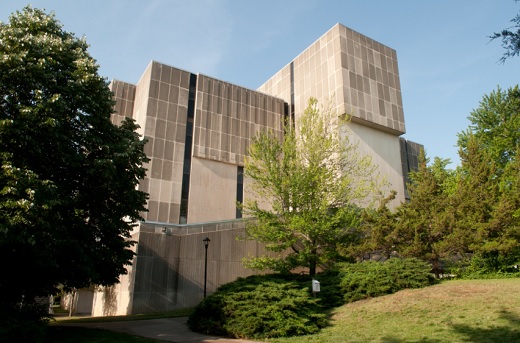 Faculty in the College of Education won an award in Australia for their work with rural communities.
Faculty in the College of Education won an award in Australia for their work with rural communities.
Jerry Johnson, chair of the department of educational leadership and Lydia E. Skeen endowed professor, and Hobart Harmon, senior research associate, were presented with the award May 24 at the 2021 Australian National Conference for Regional, Rural and Remote Education's virtual symposium. They were recognized in the category of projects based in or benefiting, rural, regional, and/or remote international settings.
Working with Australian colleagues, Johnson and Harmon implemented a collaborative leadership forum that brought together rural school principals and superintendents from Kansas, Pennsylvania and Queensland, Australia, to discuss challenges, successes and lessons learned from leading during the crisis.
"Dr. Harmon and I are honored to accept this award on behalf of K-State," Johnson said. "In collaboration with our partners in the U.S. and Australia, our work on this project not only created an opportunity for rural school leaders in Kansas, Pennsylvania and Queensland to share and learn from one another but also allowed us to celebrate the amazing work those leaders did serving their schools and communities during the pandemic."
The College of Education produced the documentary "International Rural School Leadership Project" about Johnson and Harmon's project.
APDesign landscape architect receives TreanorHL Faculty Award
 Lee Skabelund, associate professor of landscape architecture in the College of Architecture, Planning & Design, has been awarded the TreanorHL Faculty Award for 2021. This award recognizes outstanding efforts by faculty leveraging ties to design practitioners and allied industry partners to advance educational opportunities for our students.
Lee Skabelund, associate professor of landscape architecture in the College of Architecture, Planning & Design, has been awarded the TreanorHL Faculty Award for 2021. This award recognizes outstanding efforts by faculty leveraging ties to design practitioners and allied industry partners to advance educational opportunities for our students.
Skabelund has taught courses in Landscape Ecology, Land Analysis & Site Planning, Environmental Issues & Ethics, Planting Design, Research Methods, Natural Systems and Site Analysis, Natural Resources & Environmental Science, Ecological Planning, Design & Management, Landscape Architecture Design Studios, and Environmental Impact Assessment. He has worked in both public and private practice, and of particular note, led work on the following planning/design efforts: Ecological Restoration and Construction Administration at Furstenberg Nature Park in Ann Arbor, Michigan; the Sustainable Development of Forestlands Project in Southwest Virginia and Tom’s Creek Riparian Restoration Project in Blacksburg, Virginia; and the Kansas State University Stormwater Management Project, which is ongoing.
"It is fitting that Lee be chosen as the 2021 TreanorHL Faculty Award recipient," said Tim de Noble, dean of APDesign and fellow of the American Institute of Architects. "He continues to successfully leverage his ties to allied industries, particularly those involved in living rooves, evidenced not only by the financial support and toward his research efforts, but also by the growth in the number of green roofs on our K-State campus. He is a superb educator and academic whose example serves to raise the bar for all our faculty."
"Lee's collaborations with professionals and industry have created a broad and sustained array of learning opportunities associated with the K-State green roofs for a diverse set of students," said Stephanie Rolley, professor and department head for landscape architecture and regional & community planning. "For example, over the last year, Lee included a developing scholar interested in architecture, Master of Landscape Architecture students in his courses, and environmental design and planning doctoral students in research supported by JBC, a Kansas City landscape architecture firm, and Buildex, a company producing planting medium for green roofs."
The TreanorHL Faculty Award, established in 2014 is generously underwritten by the architecture, design and engineering firm. TreanorHL is a multidisciplinary firm with nine offices throughout the United States with headquarters in Lawrence.
K-State Student News
Kansas State Student Speech Language Hearing Association receives bronze chapter honors
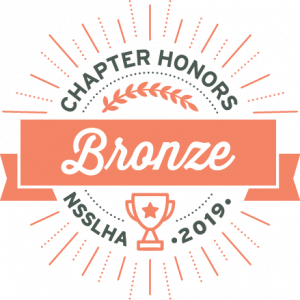 For the second year, the Kansas State Student Speech-Language-Hearing Association, KSSSLHA, has been awarded the Bronze chapter honors from the National Speech-Language-Hearing Association Executive Council.
For the second year, the Kansas State Student Speech-Language-Hearing Association, KSSSLHA, has been awarded the Bronze chapter honors from the National Speech-Language-Hearing Association Executive Council.
Bronze Chapter honors signifies that KSSSLHA has demonstrated that the future of the professions in the area of communication sciences and disorders is filled with strong leaders who are committed to serving and advocating for their clients. The KSSSHLA chapter helped to increase awareness of communication sciences and disorders and participated in the advocacy efforts with state and federal legislators.
The KSSSLHA is the officially recognized organization for undergraduate and graduate students in the communication sciences and disorders program, which is housed in the College of Health and Human Sciences.